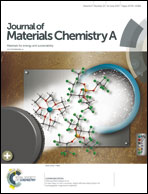Constructing an elastic solid electrolyte interphase on graphite: a novel strategy suppressing lithium inventory loss in lithium-ion batteries
Abstract
Constructing a robust and elastic solid electrolyte interphase (SEI) on a graphite anode is an important strategy to suppress lithium-inventory loss and to prolong the lifespan of the state-of-the-art lithium-ion batteries. Herein, we developed a new surface decoration method for constructing an SEI film with enhanced elasticity through an in situ polymerization of acrylate salts uniformly applied on a graphite surface. The induced growth of SEI film consisted of a flexible polymeric substrate and inherently bonded inorganic lithium salts. The new pattern of SEI geometry exhibited improved strength and elasticity. It could thus take up the volume change of the graphite material upon deep charge–discharge cycles. With 3 wt% sodium acrylate coating, the electrochemical properties of the graphite anode in terms of the first coulombic efficiency, rate capability and cycling stability were significantly enhanced. Electrochemical and morphological studies show that lithium immobilization on the graphite surface, resulting from the SEI growth upon long-term cycling, is effectively suppressed. The cycle-life of the full cell with a LiFePO4 cathode is much prolonged. The results are comparable to those obtained via adopting conventional film-forming additives of vinyl carbonate (VC) and fluoroethylene carbonate (FEC) in the electrolyte. Hence, the construction of an elastic SEI film through in situ polymerization offers a new approach to realize the next-generation lithium-ion batteries with long cycle-life and a possibility of eliminating film-forming additives in the electrolyte.



 Please wait while we load your content...
Please wait while we load your content...